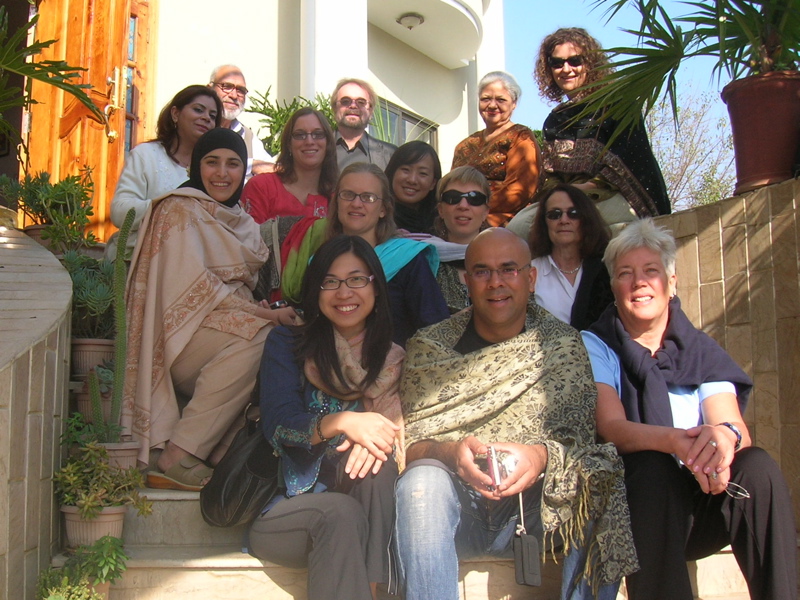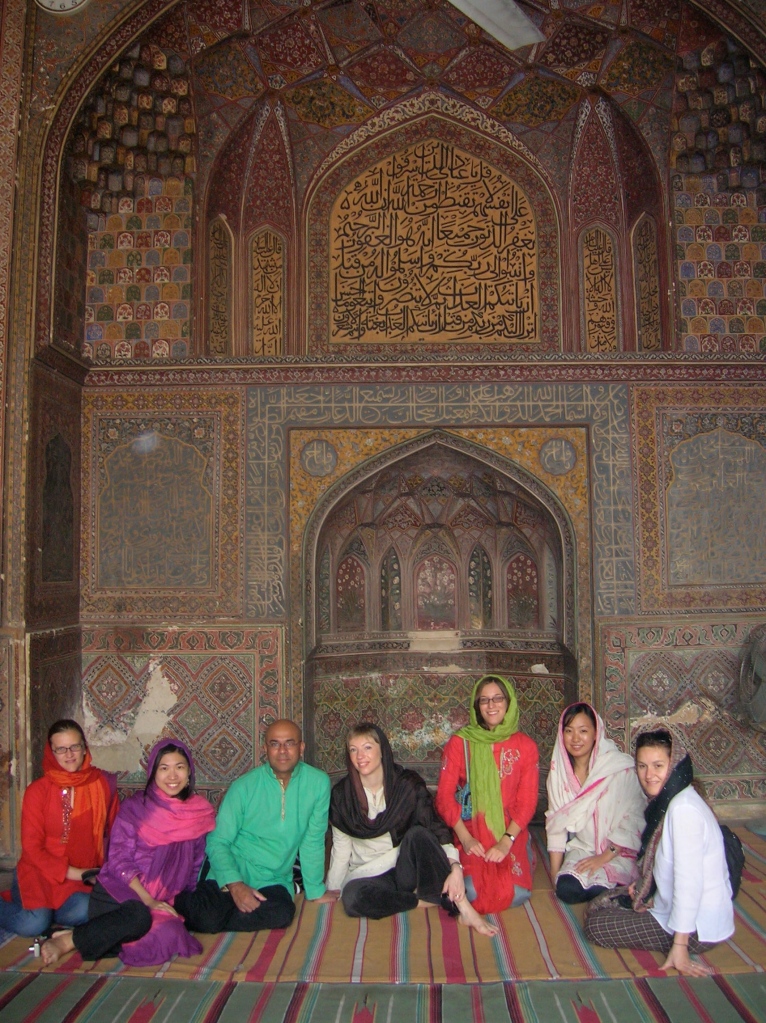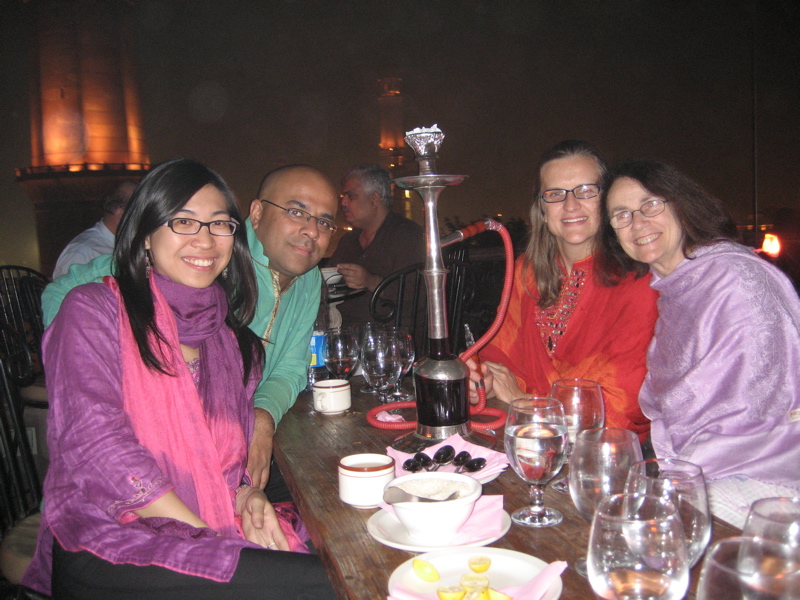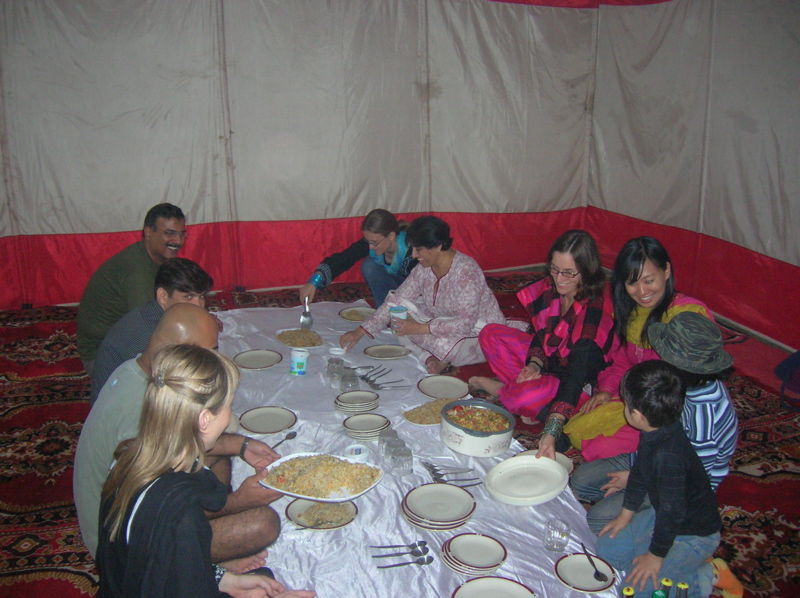How stronger ties are both politically expedient and economically advantageous for both countries.
In this article, Professor Saleem H. Ali and I collectively consider how to use ecological and economic incentives to build an unusual dyad of international relations between our two lands.
For most Australians, Pakistan remains a distant and dreaded land. The popular connection which once existed through cricket between the two countries has also been muted. Pakistani fans are unable to have any international games on their home turf for several years due to concerns about security. When Pakistani sports teams visit Australia, the reception is one of trepidation with fears of asylum seeking; add to this bad press from ostensibly Australian diseased sheep slaughtered inhumanely by local authorities in 2012. As Australia’s relations with India seem to improve, the relations with neighbouring Pakistan appear to be at best a standstill. This is alarming for the Pakistani diaspora in Australia who now number at just over 30,000, according to the 2011 Census.
With almost $90 million in aid funds allocated for Pakistan in the coming fiscal year, Australian taxpayers also deserve to be further engaged on activities between Australia and the world’s sixth largest country in terms of population. It is not enough to simply lump it together with the war in Afghanistan as a “frontline state.” Rather, it is high time Australian diplomats engage with Pakistan for investment and strategic partnership. As Australia firms its relations with China, it is also important to note the strong relationship which China has with Pakistan. The new Chinese premier, Li Keqiang, has already visited Pakistan, but has yet to visit Australia. Further, at the end of June the British Prime Minister, David Cameron, visited Pakistan to meet with the leadership in Islamabad to discuss a variety of issues, including how to enhance mutual trade and investment.
Australian political leaders have been shy of visiting Pakistan for security reasons, but former foreign minster, Bob Carr, wrote an oped for one of Pakistan’s most popular English-language dailies on 19 June of this year noting how Australia and Pakistan were “blazing trails.” The article celebrated a history of friendship between the two countries and was a positive step in recognising the salience of this relationship.
Pakistani-Australians
Migration from Pakistan to Australia has followed two parallel and equally dominant paths — the educated professionals looking for opportunities to advance their careers, and the disenfranchised minorities seeking asylum. Both these demographics have immense economic and political relevance in the current national debates on immigration.

Human connections and high politics: from left, Dr. Mehreen Faruqi; Diane Hiles; Julian Burnside QC; Ali Mohammadi (Photo credit: Alison Martin)
Originally from Lahore, Dr. Mehreen Faruqi arrived in Sydney 21 years ago. She is the first Pakistani-Australian to be elected to parliament and is a member of the New South Wales (NSW) Greens Party. Formerly Academic Director of the Master of Business and Technology Program and Associate Professor at the Australian Graduate School of Management within the Australian School of Business at the University of New South Wales (UNSW), she has just finished up at the university to assume her new role at NSW Parliament House. She has immense pride in her roots; her family were part of the Independence Movement toward the creation of Pakistan in 1947. As her family showed conviction for their ideals, so too does she – her passions being sustainability, educational and social justice and multiculturalism. On her annual trip to Pakistan to visit family, Dr. Faruqi also finds the time to collaborate with universities and NGOs to deliver short courses on sustainability and environmental management. Her endeavours extend to work on the project ‘Sustainable and Cleaner Production’, which aims to develop a model for sustainable production in the textile and tannery sectors in Pakistan and is funded by the European Commission – the textile industry being of enormous export value to Pakistan.
| Notable Pakistani Australians |
Profession |
| Fawad Ahmed |
cricketer |
| Noshi Gilani |
poet
academic |
| Sohail Inayatullah |
futurist
political scientist |
| Saeed Khan |
poet, activist
former president of PAA |
| Zaffar Khan |
author, life coach, speaker
GM of Dial-a-Doctor |
| Usman Khawaja |
cricketer |
| Mustafa Qadri |
founder and executive director of equidem research and consulting |
| Iftikhar Rana |
president of PABC
former president of PAA |
| Waqar Younis |
cricketer
sports commentator |
| Irfan Yusuf |
lawyer
social commentator |
Despite the challenges of education in their land of origin, Pakistani immigrants generally place a very high value on education; and as Dr. Faruqi confirms: “[as a Pakistani immigrant] it isn’t a matter of ‘if’ you will go to university, but ‘what you will study’ when you go to university” – further reflected in data through the Department of Home Affairs, where, in Australia, around 50 per cent of those born in Pakistan hold an undergraduate degree or higher qualification, versus 20 per cent for the rest of Australia. Apart from being well-educated, Pakistani-Australians are also young – 52 per cent are 25 – 44 years; 29 per cent are professionals and 10 per cent are in managerial roles.
 Source: Department of Home Affairs, Immigration and Citizenship
Source: Department of Home Affairs, Immigration and Citizenship
The diaspora has spawned organisations such as the Pakistan Association of Australia – PAA – which serves to raise cultural awareness of the Pakistani community. The strong philanthropic and charitable ethos of the association has seen its involvement in various fundraising activities for both Pakistan and Australia, including the 2010-2011 floods in Southern Queensland. Another organisation, the Pakistan Australia Business Council – PABC – identifies potential business links, facilitates introductions and cements such connections between Australian and Pakistani business people; in particular, in the medical surgical instruments sector, as well as in the textile and arts-and-crafts sectors. The association’s president, Mr. Iftikhar Rana, indicates that Australian businesses are impressed with the overall quality and price of Pakistani products but there is clear risk aversion that prevents broader investment. Yet, from BHP’s investment in the Zamzama gas field to dairy farm improvement technologies, Australian businesses have found opportunities in the country despite the security cautions.
Solar opportunity
Entrepreneurs are often the motivating forces for investment in emerging markets, often spurred by the growth potential of new technologies. Jeremy Higgs is one such Australian entrepreneur making a distinct impression on Pakistan. He first went there on an AIESEC program in October 2007 and has been based in Karachi ever since. Until March 2013, Jeremy was the Executive Officer of the Network of Organizations Working for People with Disabilities, Pakistan – NOWPDP – part of the Aga Khan National Council for Pakistan. While with NOWPDP, interest in another venture was simmering away in the background and Eco Energy Finance was born on 1 April 2013, with Jeremy as co-founder and director of operations. Pakistan’s unreliable – and at times non-existent – source of electricity means that around 65 million people are off the energy grid altogether in a country with a population of just over 180 million; and as per usual, it is the ‘last-mile’ people who have the least access to resources. Eco Energy Finance seeks to address this considerable gap.
Initially, this social enterprise received a grant from an investment firm in the USA and also raised donations. The company distributes solar-powered lamps to areas around Badin and Thatta, in the Province of Sindh. In 2012, the Pakistani government removed customs duties and sales tax on solar products – a considerable incentive and potential business opportunity.
The strong social ethos of Eco Energy Finance is having profound effects in the reduction of energy poverty. This renewable energy source eliminates the cost of replacement batteries and kerosene for hand-held torches and kerosene lamps – the main source of lighting up until now. Women do embroidery by the light for longer hours and these products generate income for the villagers and their communities. The income from this brighter and cleaner light source goes toward repayment of the loan they had to purchase the lamp. Indeed, such positive economic, health, educational, and environmental impacts can be described as a true investment in the future of Pakistan.
Speaking from his home in Karachi, Jeremy admits that the wait for the visa from the Ministry of Interior was drawn out and while many Pakistanis show a curiosity towards him, he has not been on the receiving end of any overt xenophobic experiences. When asked what has captivated him about Pakistan, he responds matter-of-factly: “The entrepreneurial ethic.” It appears as if this young entrepreneur is living just that.
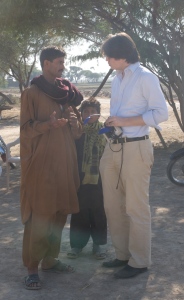
The power of solar: Australian entrepreneur, Jeremy Higgs of Eco Energy Finance, displaying a lamp from Sydney-based company, Barefoot Power, in rural Pakistan (Photo credit: Eco Energy Finance)
The Australian connection with Eco Energy Finance also extends to the technology which they use for the portable lamps. The manufacturer of these lamps is a Sydney-based company, Barefoot Power, whose CEO, Rick Hooper, identifies his firm as a social-for-profit company, which seeks to improve livelihoods in areas which have an unreliable or non-existent electricity supply. Rick affirms that the benefits to people and communities are palpable. Small vendor shops trade for up to four extra hours per day, due to use of the Barefoot lamps in their shops. Considerable demand for more products means Barefoot is continuously adapting new products specific to the Pakistani market and its CEO forecasts an exponential growth in the Pakistani market in the coming years.
Aid versus trade
In comparison with around $90 million in annual aid delivery from Australia to Pakistan in 2012, trade flow between the two countries in the same year was around $870 million. All the same, as the Pakistani Consul General in Sydney, Abdul Aziz Uqaili, admits, it is heavily tilted in favour of Australia, due to the import of high demand Australian products into Pakistan.” He adds that further trade imbalance is caused by education services to Pakistani students and the continual high demand for technical assistance machinery for textile production. To the detriment of bilateral trade links, current duty rebates to Least Developed Countries – LDCs – prompt Australian buyers to source products from countries with duty incentives; however, a promising sign is the withdrawal of these duty incentives to LDCs by the end of 2014, which will pave the way to allow Pakistani exporters increased opportunities in Australia. The Consul General is also hopeful for a successful outcome to allow the importation of the citrus fruit, kinno, the next step in trade negotiations between the Pakistani Mission in Australia and Australian authorities.
While the number of business visas issued for travel to Pakistan for 2012 was up on 2011, it is still relatively minor at 216 and 141 respectively, largely due to security concerns. Yet, there are opportunities for Australian businesses to invest without the need for in-country foreign staff, through franchise business models. Gloria Jean’s Coffee and Irish company Butlers Chocolate Cafés have followed such a path and Austrade is exploring other business opportunities. Nicola Watkinson, Senior Trade and Investment Commissioner for South Asia based in New Delhi, is buoyed by a “strong interest in how [businesses in Pakistan] can grow and take on opportunities”, along with a general openness to discussion. Austrade identifies the agribusiness and energy sectors as the main opportunities for commercial collaboration between Australia and Pakistan. Given that food security is an issue in South Asia, Austrade’s resource focus is on working with citrus and sugarcane growers and, dairy and cattle farmers in development, strategic engagement and growth opportunities. Ms. Watkinson recognises the potential with regard to the renewable resources sector, acknowledging Australia’s innovation and industry expertise – specifically in the solar sector – as a useful resource to be applied in a number of areas, which includes in the agribusiness sector, for domestic use and in the construction of a solar-powered desalination plant in Karachi to convert seawater to drinkable water.
An area of the service sector that remains untapped is the call centre phenomenon, such as has been established in India and the Philippines. Harnessing the skills of Pakistan’s considerable English-speaking population and its quality, reliable telecommunication links is certainly worth due consideration. Further, potential opportunities for Australian businesses to cultivate prospects without the need for in-country foreign staff lie in the highly developed information-technology industry. While Austrade denies a current high demand in this industry, a multi-million dollar partnership agreement has been struck between an Australian investor and a Pakistani biometric research and integrated workforce management company for the development of next generation biometric solutions, such as Retina, Iris, 3D Face and Palm Vein recognition algorithms, with a focus on Australian security, payments, and workforce management.
In recent years, education services have become a high priority of Australia’s broader foreign policy agenda; in particular, intake of international students, whether scholarship recipients or fee-paying. People-to-people links certainly have advantages for future potential business ties; however, the cons due to relocation from one’s home environment are potentially fraught with issues, such as separation from family and various other accompanying social problems. If use of aid funds were to centre on infrastructure development inside Pakistan for institutional facilities, teacher qualifications and ongoing professional development within the education sector, this would goad well toward a mutually constructive long-term investment strategy. Capacity building in the educational sector – in particular, at primary and secondary levels – is paramount in order to induce a concomitant effect of stabilising in-country security and building confidence of foreign investors while preventing exodus of human capital.
Asylum alternatives
While the asylum-seeker debate endures and regional settlement alternatives on Nauru and in Papua New Guinea are in their fledgling stages, recent boatloads continue to arrive with Pakistanis on-board; testament to the grim situation from which they are fleeing. Harken back to the 1970s, when the incumbent government wanted people to flee Vietnam because it helped bolster the Cold War ideological campaign against the ‘evils of communism’. Public opinion was therefore mostly in favour of accepting people arriving by the boatload, whereas today it is the polar opposite. Is contemporary public opinion a reflection of government ideology or is the government a reflection of its constituents’ will? Australian taxes used to fund the entire asylum-seeking infrastructure would be better syphoned toward strengthening governmental, educational and energy infrastructures inside Pakistan. The table below shows the types of visas issued to individuals of Pakistani origin in the 2011-2012 financial year and pertain to permanent arrivals (except as students and for business visas – the latter are noted for calendar year 2011).
| Type of visa |
Number of visas issued |
| Family migration |
845 |
| Skilled migration |
1862 |
| Students |
6203 |
| Business (temporary) |
900 |
| Special eligibility |
5 |
| Humanitarian |
84 |
| Protection visa grants |
403 |
| New Zealand citizens |
91 |
| Other non-program |
26 |
Source: Department of Immigration and Citizenship
Dr. Faruqi affirms that developed countries, such as Australia, should take a leadership role on environmental issues and agrees that Australia, in its support to Pakistan, could encompass investment in the solar energy and hydropower sectors with regard to infrastructure development: “International aid is one way Australia can support Pakistan to move to a cleaner, renewable energy future; but to be successful, long-lasting programs and projects have to be developed in consultation with the communities on the ground, not using a top-down approach. The aim has to be to increase local capacity and empower communities to be self-sufficient.” With some foresight, capacity building in these sectors holds the potential to empower all stakeholders.
A more concerted approach to strategic investment – in particular in the renewable energy sector – would hold numerous mutual benefits. Dr. Faruqi adds that avoiding the use of untapped coal in Pakistan, reduction in the dependency on oil and stimulation of economic growth through a reliable energy supply are some of the advantages. Further benefits encompass improved education and health outcomes – in particular for women and children – fulfilment of basic needs of communities and poverty reduction. A rethink in the strategic use of aid could assist to stem the need for the vulnerable and marginalised to flee in utterly hopeless, desperate and urgent circumstances. It would therefore make more sense and, at the same time, be more mutually advantageous to strengthen educational, as well as other institutions inside Pakistan. To this end, the creation of opportunities inside Pakistan should be a fundamental strategic goal.
The way forward
Indeed, there are serious challenges which confront Pakistan in terms of energy shortages, industrial closures and the continuing scourge of extremism. Still, Pakistanis continue to be among the most successful diaspora communities and despite all the turmoil, foreign remittances have kept the country on an economic growth path albeit far more slowly than development professionals would have hoped. Australian investors have an edge over British and American investors in the country because of a generally far more positive impression of Australia and Canada in Pakistan than the other two anglophone heavy-weights. Yet, Australia and Canada have kept Pakistan at arm’s length with modest aid programs and few serious efforts at trade and investment. Despite its many challenges Pakistan is still the world’s second-largest exporter of textiles with a fairly experienced industrial workforce. Even with all the negative media attention, Pakistan ranks higher than India by more than 20 points on the World Bank’s Ease of Doing Business Index. Nicola Watkinson concurs with this comparative assessment. Since assuming her new role earlier this year, she has visited Pakistan and is “upbeat” about the country’s prospects and particularly impressed with a “stronger international outlook than expected” and “high level of entrepreneurialism” of Pakistani businesses.
Australians who dare to defy the Department of Foreign Affairs and Trade (DFAT) travel warnings are often pleasantly surprised by the level of developed infrastructure in the country. Pakistan does indeed face development challenges; but, if the negativity and reluctance to engage continue it will simply make matters worse and an opportunity for mutual gains for countries such as Australia will be missed. As noted by the regional manager of Austrade in Pakistan, Azhar Shah, “the opportunities for cooperation between Australia and Pakistan are considerable but some leadership and persistence is needed.” Mr. Shah noted that the import of Pakistani mangoes into Australia is one example which is being actively pursued. The United States and Canada have allowed mango imports from Pakistan for some years, but Australia only agreed to their import in September 2013 and commercial prospects are now being explored.
Australia’s aid program also has a regional dimension for South Asia, but there has been scant effort to use aid as a diplomatic means to improve relations between countries in the region, particularly India and Pakistan, or as a stimulus for trade opportunities. Even with the recent change of government, Australia’s foreign policy remains a perennially debated topic; the importance of a regional approach to South Asia and the salience of Pakistan must be considered more directly. The constructive role Australia can play in this pivotal and relatively proximate part of the world needs clear leadership and agency, particularly following the withdrawal of troops from Afghanistan. Stability in South Asia is only possible if Pakistan can be constructively engaged with clarity and without condescension.
Original article published in National Geographic in 2013.



